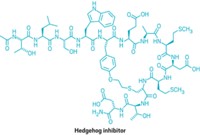Advertisement
Grab your lab coat. Let's get started
Welcome!
Welcome!
Create an account below to get 6 C&EN articles per month, receive newsletters and more - all free.
It seems this is your first time logging in online. Please enter the following information to continue.
As an ACS member you automatically get access to this site. All we need is few more details to create your reading experience.
Not you? Sign in with a different account.
Not you? Sign in with a different account.
ERROR 1
ERROR 1
ERROR 2
ERROR 2
ERROR 2
ERROR 2
ERROR 2
Password and Confirm password must match.
If you have an ACS member number, please enter it here so we can link this account to your membership. (optional)
ERROR 2
ACS values your privacy. By submitting your information, you are gaining access to C&EN and subscribing to our weekly newsletter. We use the information you provide to make your reading experience better, and we will never sell your data to third party members.
Synthesis
Chiral Route To Key Anticancer Agent
First enantioselective synthesis of nutlin-3 could lead to analogs for cancer studies
by Stu Borman
April 11, 2011
| A version of this story appeared in
Volume 89, Issue 15
Researchers have devised the first enantioselective synthesis of the small molecule nutlin-3, a key member of a family of compounds that are tools for cancer research and promising leads for anticancer drug discovery (Chem. Sci., DOI: 10.1039/C1SC00061F).
Nutlins were discovered by researchers at Hoffmann-La Roche, Nutley, N.J. (Science, DOI: 10.1126/science.1092472). The company has a nutlin analog, RG7112, in clinical trials for leukemia and advanced solid tumors. The new synthesis currently produces only nutlin-3 but has the potential to be adapted for the synthesis of other nutlin derivatives.
Nutlin-3 is widely used to study the role of the tumor-suppressing protein p53. In normal cells, p53 triggers apoptosis, a pathway by which damaged or unwanted cells initiate their own destruction for the good of the organism. But this p53-initiated apoptosis pathway is turned off in cancer cells, allowing them to divide without limit. Nutlin-3 binds the p53-regulating protein MDM2, causing p53 and apoptotic tumor-suppression activity to be turned back on in tumor cells.
Nutlin-3 and other nutlins are “the most important chemical biology and pharmacological tools for studying apoptosis via the p53-MDM2 signaling pathway,” says associate professor and Director of Medicinal Chemistry Gregory P. Roth, who specializes in anticancer agents at Sanford-Burnham Medical Research Institute, in Orlando.
But nutlin-3’s cost has stymied its use in apoptosis research. It’s chiral—one enantiomer binds MDM2 151 times better than the other. But the only known synthesis, reported by Roche in patents, creates an equal mixture of two enantiomers, from which the more active enantiomer has to be separated by an expensive chiral chromatography process.
Now, grad student Tyler A. Davis and chemistry professor Jeffrey N. Johnston of Vanderbilt University have devised the first enantioselective synthesis of the compound. “Our goal was to open synthetic access to nutlin-3 and other derivatives to communities interested in this powerful class of small molecules,” says Johnston.
Davis and Johnston developed a new catalyst that drives a carbon-carbon bond-forming reaction that combines two halves of the molecule, creating an intermediate with the basic structural framework found in all nutlins. “We then developed a sequence of steps that convert the intermediate into nutlin-3 without progressing through a symmetrical intermediate,” Johnston says.
“Our route brings derivatives into the reach of any laboratory with even moderate skills in organic chemistry and alleviates the need for an expensive chiral column,” he says. “This is a scenario in which organic synthesis and small-molecule-guided biology are so much more than the sum of their parts, and one can sense that important new work will be accelerated as a result.”
“The Johnston group has demonstrated a best-in-class synthesis that will allow investigators to prepare new analogs to further probe the p53-MDM2 biochemical pathway,” Roth comments.
R. Kiplin Guy, chair of chemical biology and therapeutics at St. Jude Children’s Research Hospital, in Memphis, and an expert on nutlin and other anticancer agents, says the new route “has a nice use of chiral reagents, a nice desymmetrization, and should adapt well to process synthesis. It is definitely a step forward.”






Join the conversation
Contact the reporter
Submit a Letter to the Editor for publication
Engage with us on Twitter